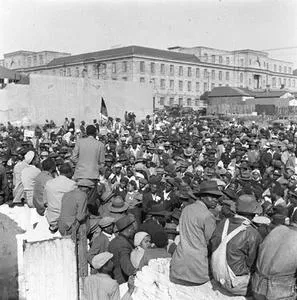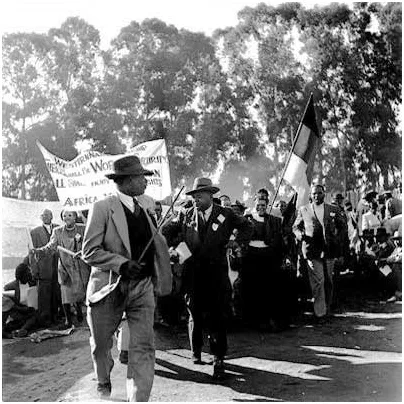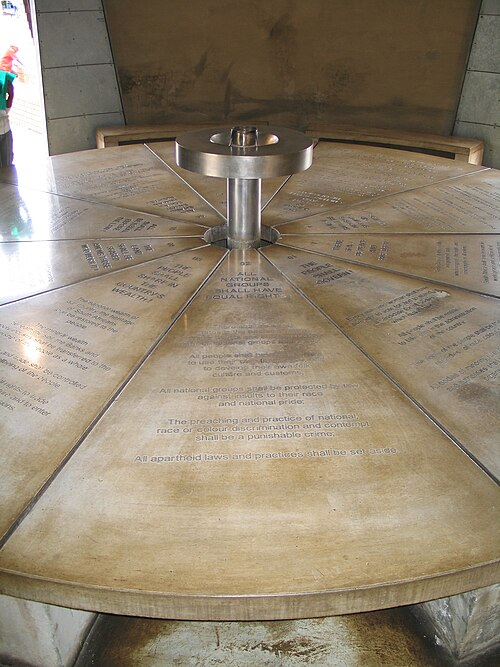IB Syllabus focus:
'The philosophy, strategy, and execution of non-violent protests.
The creation, content, and significance of the Freedom Charter.
Governmental and public responses to non-violent protests.'
As apartheid's oppressive laws tightened their grip on South Africa, a counter-movement blossomed, championing the values of peaceful resistance and unity. The non-violent protests, alongside the emblematic Freedom Charter, paved a significant path for opposition to apartheid.
Philosophy of Non-Violent Protests
Non-violent resistance wasn't merely about abstaining from physical violence; it was a deeply strategic and morally grounded approach.
Moral High Ground
Advocates believed that through non-violence, they could showcase the stark contrast between their peaceful methods and the brutal responses of the apartheid regime.
It was perceived that this approach would underscore the moral bankruptcy of apartheid, eroding its domestic and international support.
Mass Mobilisation
The non-violent approach was inclusive. Without the deterrent of violence, individuals, irrespective of age, gender, or physical capability, could actively participate.
This inclusivity meant larger numbers, making the movement more visible and harder for authorities to suppress.
Global Sympathy
Peaceful protests, especially when met with disproportionate force, generated global outrage.
International media often covered such events, ensuring that the world became increasingly aware of and sympathetic to the anti-apartheid cause.
Strategy and Execution
Execution was paramount. Leaders ensured that protests were not just symbolic, but also had tangible impacts.
Mass Action
Strategies included work stoppages, boycotts of apartheid-supporting businesses, and civil disobedience. Notably, the Defiance Campaign of 1952 involved acts of peaceful defiance against discriminatory laws.

A Congress Alliance mass meeting during the 1952 Defiance Campaign exemplifies planned, disciplined civil disobedience—central to the movement’s strategy of non-violent mass action. Such gatherings mobilized thousands and drew public attention to the injustice of apartheid laws. Source
Such mass actions disrupted the economy and put pressure on the government to address protestors' demands.
Awareness Raising
Protests served dual purposes: firstly, to rally South Africans against apartheid, and secondly, to draw international attention and support.
Leaders like Albert Luthuli and Walter Sisulu often spoke at these events, articulating their cause's moral and political underpinnings.
Legal Opposition
Parallel to the protests, there were concerted efforts to challenge the legal foundations of apartheid. Lawyers like Nelson Mandela and Oliver Tambo took apartheid laws to court, highlighting their injustices.
The Freedom Charter
A beacon for many, the Freedom Charter was both a declaration of intent and a blueprint for a democratic South Africa.
Creation
The charter wasn't drafted by a select few in closed rooms. Instead, it was a bottom-up process where volunteers gathered "freedom demands" from South Africans across the country.
This extensive and democratic process culminated in the Congress of the People in 1955, held in Kliptown, where the Freedom Charter was adopted.

Delegates gather at the Congress of the People in Kliptown on 26 June 1955 to adopt the Freedom Charter, synthesizing “freedom demands” collected nationwide. The image captures the scale and multi-racial composition of the assembly that gave the Charter its legitimacy. Source
Content
Equality: The charter's preamble boldly declared, "South Africa belongs to all who live in it, black or white." This set the tone for its subsequent clauses.
Land and Wealth Redistribution: The charter recognised the economic foundations of apartheid and thus called for land to be distributed amongst all, and the nation's wealth to benefit everyone.
Rights and Freedoms: It encapsulated various rights, like the right to work, freedom of movement, and freedom of expression. This holistic view was groundbreaking at a time when many of these rights were brutally suppressed.
Significance
Unified Vision: It consolidated diverse anti-apartheid sentiments into a coherent vision for a future South Africa.
Mobilisation Tool: The charter galvanised people. Its reading and distribution often became rallying points for various anti-apartheid activities.
Legacy: The Freedom Charter’s ideals found their way into South Africa's democratic constitution, a testament to its enduring vision.

The Freedom Charter Memorial at Kliptown commemorates the 1955 adoption and its lasting place in South Africa’s democratic story. While the memorial is a later installation, it illustrates how the Charter’s principles continue to be publicly honored. Source
Governmental and Public Responses
The apartheid government's reactions were predictably oppressive. Yet, these reactions often served to further validate the protestors' cause.
Apartheid Government
Repression: The state often employed brutal tactics, including arrests, beatings, and torture. The peaceful nature of the protests made these responses appear particularly savage.
Banning of Organisations: Alarmed by the growing influence of groups championing the Freedom Charter, like the ANC, the government banned them in 1960.
Tightening of Laws: The government’s typical modus operandi was introducing even stricter laws in response to opposition, further stifling resistance.
International Community
Growing Condemnation: As the realities of apartheid became clearer to the global audience, many nations began criticising the South African government.
Sanctions and Boycotts: Countries started imposing economic sanctions, while many organisations and individuals initiated boycotts of South African goods, particularly during the 1960s.
General Public
Increased Support: As the movement's successes and the government's brutalities became evident, support swelled from diverse racial and economic backgrounds.
Empowerment: To many, especially the black majority, the Freedom Charter was more than a document—it was a symbol of hope and empowerment, a promise of a brighter, inclusive future.
These notes seek to give a comprehensive understanding of the philosophy, strategies, and significance of non-violent protests and the Freedom Charter during apartheid's dark days. The sacrifice, resilience, and vision encapsulated in this era remain crucial lessons in the annals of world history.
FAQ
Yes, the non-violent approach faced internal criticism, especially as the apartheid regime responded with increasing brutality. Some activists and factions within the anti-apartheid movement felt that non-violence was ineffective and allowed the state to continuously oppress without significant consequence. They believed a more militant approach was required to genuinely challenge the state's machinery. This sentiment grew stronger, especially after events like the Sharpeville Massacre. The formation of Umkhonto we Sizwe (Spear of the Nation), the armed wing of the ANC, in 1961, was a testament to these feelings. It symbolised a shift in strategy, embracing the idea that while non-violence was noble, it might not be sufficient on its own.
South African Indians, though a minority, played a pivotal role in the non-violent resistance against apartheid. Leaders like Mahatma Gandhi, during his tenure in South Africa, laid the groundwork for peaceful resistance against racial discrimination. This philosophy was embraced by many South African Indians. The South African Indian Congress (SAIC), aligned with the ANC, was instrumental in organising and participating in campaigns against apartheid laws. The joint collaboration of these groups culminated in significant events like the Defiance Campaign. Through solidarity and shared vision, the Indian community significantly contributed to the broader multi-racial struggle against apartheid.
Women were integral to the anti-apartheid movement and the non-violent protests. They were not just passive participants but active leaders and organisers. In 1956, 20,000 women marched to the Union Buildings in Pretoria in protest against the pass laws, showcasing their commitment to the cause. Their slogan, "You strike a woman, you strike a rock," became iconic in the struggle. Regarding the Freedom Charter, women ensured their voices were heard. They contributed to its creation by sending in their freedom demands and ensuring the Charter addressed their specific concerns. Their active involvement underlined the intersectionality of the anti-apartheid movement, where the fight against racial oppression intertwined with gender issues.
While the Freedom Charter served as a significant inspiration for the post-apartheid South African Constitution, there are notable differences. The Charter demanded land redistribution, nationalisation of major industries, and wealth redistribution – radical economic transformations aimed at undoing apartheid's economic injustices. In contrast, the 1996 Constitution adopted a more centrist approach. While it does uphold the principles of justice, equality, and human rights as the Charter did, it is more cautious in its approach to economic transformation. The Constitution provides for land restitution but stops short of endorsing widespread land seizures without compensation. It strikes a balance between addressing historical injustices and ensuring economic stability and growth.
The Defiance Campaign of 1952 was a mass resistance movement organised by the African National Congress (ANC) alongside the South African Indian Congress. Its goal was to resist the oppressive apartheid laws using non-violent civil disobedience. Activists and participants intentionally broke racially discriminatory laws, leading to their arrests. The idea was to flood the prison system and make the enforcement of apartheid laws unmanageable for the government. The campaign highlighted the unjust nature of apartheid, attracting significant domestic and international attention. While it didn't achieve immediate policy changes, it marked a key moment in the non-violent resistance against apartheid, strengthening the unity of the oppressed communities and setting the tone for future protests.
Practice Questions
The Freedom Charter was a seminal document in the anti-apartheid struggle, encapsulating the collective aspirations of countless South Africans. Crafted through a bottom-up process, it represented a diverse and democratic voice against racial segregation. Its emphasis on equality, land redistribution, and basic rights was revolutionary, setting a vision for a post-apartheid South Africa. While it galvanised internal resistance, it also provided a clear framework for international allies to rally behind. The charter's enduring legacy is evident in its influence on South Africa's democratic constitution, underlining its pivotal role in the nation's journey to freedom.
The philosophy of non-violent protests was underpinned by moral and strategic considerations. Morally, it underscored the stark ethical differences between the peaceful protestors and the brutally oppressive apartheid regime, highlighting the latter's injustices. Strategically, non-violence allowed for mass mobilisation; it encompassed a wide demographic, making the movement more robust and visible. Tactics like work stoppages and boycotts had tangible economic impacts, adding to the pressure on the government. Moreover, the peaceful nature of these protests, especially when met with excessive force, garnered global sympathy, increasing international pressure on the apartheid government. In essence, non-violence amplified the anti-apartheid voice, making it harder to ignore both domestically and internationally.

